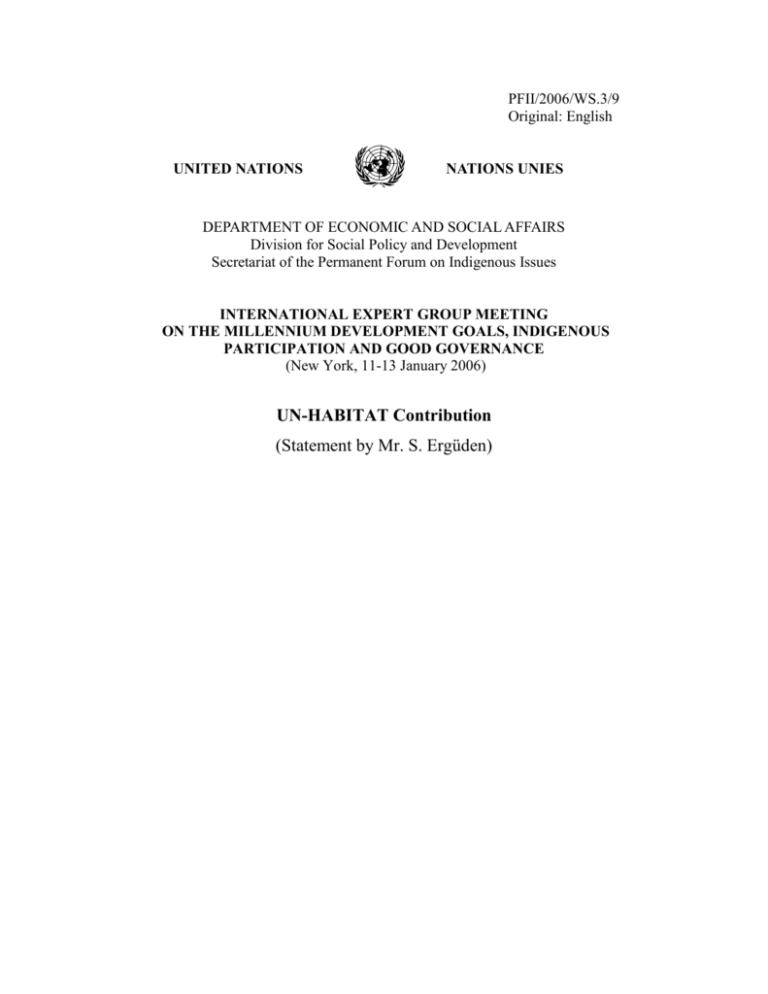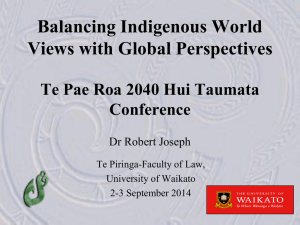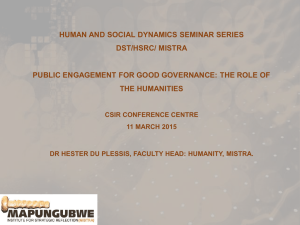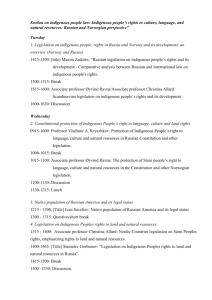Millennium Development Goals, indigenous participation and good
advertisement

PFII/2006/WS.3/9 Original: English UNITED NATIONS NATIONS UNIES DEPARTMENT OF ECONOMIC AND SOCIAL AFFAIRS Division for Social Policy and Development Secretariat of the Permanent Forum on Indigenous Issues INTERNATIONAL EXPERT GROUP MEETING ON THE MILLENNIUM DEVELOPMENT GOALS, INDIGENOUS PARTICIPATION AND GOOD GOVERNANCE (New York, 11-13 January 2006) UN-HABITAT Contribution (Statement by Mr. S. Ergüden) Millennium Development Goals, Indigenous Participation and Good Governance,11-13 January 2006 UN-HABITAT Statement of Selman Ergüden Chief, Housing Policy and Development Section Coordinator, United Nations Housing Rights Programme GOOD URBAN GOVERNANCE AND INCLUSIVE CITIES: THE NEED FOR EMPOWERING VULNERABLE AND DISADVANTAGED GROUPS INCLUDING INDIGENOUS PEOPLE Most of humanity will soon live in cities, and the trend of urbanization is irreversible. Cities in general are the engines of economic and social development, creating jobs as well as generating creative and innovative civic cultures. Cities today, however, can also generate and intensify social exclusion, limiting the benefits of urban life to the poor, to women, to youth, and other marginalized groups including indigenous peoples. The majority of indigenous peoples still live in rural areas in general; but the limited available data shows that these peoples are increasingly migrating - either temporarily or permanently - to urban areas. The deterioration of their traditional livelihoods and the absence of viable alternatives in their communities of origin urge them to migrate to cities and become in most cases self employers and or wage earners in informal sectors. Migration for work - international and/or national - is becoming an important way out for indigenous peoples. As summarized in the box 1, they try to organize themselves to better cope with the new environment and economic and social conditions. They try to support their families left behind. Remittances of indigenous migrant workers have become a very important source of income and well-being for many rural indigenous communities. It is observed that urban-based indigenous people maintain close ties with their communities of origin, but, over time, their attachment to their traditional lands becomes weaker and land-related issues less important, as other concerns arise1. Currently about one billion people live in urban slums globally. Despite this there is limited information and data specific to housing conditions of indigenous people and to 1 Indigenous and Tribal Peoples, Manuela Tomei, ILO, 2005,Geneva 2 what extent they are urban, it would be good estimate that quite a good share of indigenous people in urban locations do live in slums2. It is UN-HABITAT's experience, derived from nearly 30 years of work with cities, that the key ingredient to realizing the “Inclusive City” is basically through good urban governance. This argument needs to be considered in the broader policy and operational context of the Habitat Agenda and the international community’s efforts for poverty reduction. There is increasing consensus that good governance is key for sustainable human and settlements development. 2 Indigenous Peoples’ right to adequate housing, UN-HABITAT, 2005, Nairobi 3 Migrant indigenous peoples: A case from Mexico City The Assembly of Migrant Indigenous Peoples of Mexico City is a coalition of 15 indigenous organizations representing indigenous migrants from ethnic groups. Each organization claims a membership of about 850 members. The main goal of the Assembly is to preserve the ethnic Identity of their members by re-creating and consolidating, in an urban context, their traditional community institutions. These include the "tequio", a mutual help system, and their customary forms of governance. Another aim of the coalition is to expose mainstream society to their culture, music, dance and traditions with a view to creating a multi-cultural society. The Assembly advocates the legal, social and cultural recognition of migrant indigenous organizations by local and federal governments. It also presses for socially inclusive public policies, such as bilingual and multicultural education programmes, health programmes that are aware of traditional indigenous healing practices and beliefs, a system of justice that is respectful of indigenous customary law, programmes promoting discrimination-free jobs, and urban planning policies adapted to their requirements, e.g., availability of communal buildings for community gatherings. Thecontributing Assembly's on the recognition of Agenda the value of UN-HABITAT is increasingly to emphasis the implementation of the Habitat their ethnic identity by mainstream society reflects a desire for greater inclusion and as a “global advocacy agency” with the two global campaigns as entry points. The for playing a constructive role inaddresses national the life.goal of “adequate shelter for all”; and Global Campaign for Secure Tenure theSources: Global Indigenous Campaignand onTribal Urban Governance goal of “sustainable human Peoples, Manuelaaddresses Tomei, ILO,the 2005,Geneva settlements development”. The two campaigns are linked by their common focus on urban poverty reduction. UN-HABITAT’s experience is that participatory processes are the best means for effective and equitable use of scarce development resources, in a sustainable way. The goal of the Global Campaign on Urban Governance is to reduce urban poverty through good urban governance, and the theme of the campaign is the “Inclusive City” because it is both the vision and the strategy for achieving it. In collaboration with major partner groups and key stakeholders, the campaign gathers and builds upon lessons of experience through operational activities at the city level. It develops tools, guidelines and policy and legislative frameworks from those lessons. Lessons learned are fed into the refinement of norms of good urban governance, which forms the basis of all publicity, information and advocacy work. The concept of governance is complex and controversial. Before one can say what is “good” governance, one must be clear about what is meant by “governance.” An entry point into this debate may be UNDP’s definition: The exercise of political, economic and administrative authority in the management of a country’s affairs at all levels. It comprises the mechanisms, processes and institutions through which citizens and groups articulate their interests, exercise their legal rights, meet their obligations and mediate their differences.3 3 UNDP Governance for Sustainable Human Development, New York, 1997, pp. 2-3. See also the draft Working Consensus Definition of Governance presented to the U.N. Consultative Committee on Programme and Operational Questions (ACC/2000/POQ/CRP.20 of 14 September 2000). 4 Two aspects of this definition are relevant for the campaign. First, governance is not government only. Governance as a concept recognizes that power exists inside and outside the formal authority and institutions of government. In many formulations, governance includes government, the private sector and civil society. Second, governance emphasizes “process.” It recognizes that decisions are made based on complex relationships between many actors with different priorities4. The idea of the “Inclusive City” has global applicability – north as much as south. The notion of inclusion, however, has a different resonance in each region with exclusion of specific groups being most significant in some regions and exclusion of the poor majority more important in others. In most cases however poverty and exclusion go together. The governance campaign aims to promote various policies and practices, depending on context, to strengthen inclusiveness which may vary from region to region and from city to city. Providing individuals and groups with the goods they need in order to effectively participate in society, such as land and infrastructure, may be most appropriate in some cities. In others, empowering groups and individuals to strengthen their ability and willingness to participate in society, may be the key. Concern for future generations and the institutional frameworks that determine the formal and informal incentives for inclusion, may be of particular importance in all regions. A rights-based approach, which emphasizes the right to development and provides a framework for poverty reduction based on realization of civil, cultural, economic, political and social rights, sets a common framework. An inclusive process is vital to the success of any attempt to define universal norms (or desired principles) of good urban governance. The norms must be relevant to the realities of cities and all stakeholder groups, particularly those often excluded from such processes. Women and children and particularly disadvantaged and vulnerable groups including indigenous people must be encouraged and enabled to participate. International legal instruments; commitments made by governments at major United Nations conferences; and operational experience in cities are the three potential areas to form the framework of such global norms. Implementation of these approaches wherever their focus may be must be grounded in the reality of urban planning and management. Good urban governance is characterized by the principles of sustainability; subsidiarity; equity; efficiency; transparency and accountability; civic engagement and citizenship; and security. These principles which are summarized below, must be interdependent and mutually reinforcing5. 4 5 Global Campaign on Urban Governance, UN-HABITAT, Concept Paper 2nd Edition: March 2002 Summarized from Global Report on Human Settlements 2003, UN-HABITAT, Nairobi 5 Sustainability in all dimensions of urban development Cities must balance the social, economic and environmental needs of present and future generations. This should include a clear commitment to urban poverty reduction. There should be long-term, strategic vision of sustainable human development. Subsidiarity of authority and resources to the closest appropriate level Responsibility for service provision should be allocated on the basis of the principle of subsidiarity - that is, at the closest appropriate level consistent with efficient and costeffective delivery of services. Decentralization and local democracy should improve the responsiveness of policies and initiatives to the priorities and needs of citizens. Cities and local authorities should be empowered with sufficient resources and autonomy to meet their responsibilities. Equity of access to decision-making processes and the basic necessities of urban life The sharing of power leads to equity in the access to, and use of, resources. Women and men must participate as equals in all urban decision-making, priority-setting and resource-allocation processes. Inclusive cities provide everyone - whether the poor, young or older persons, and all marginalized groups with equitable access to services. Efficiency in the delivery of public services and in promoting local economic development Cities must be financially sound and cost effective in their management of revenue sources and expenditures, the administration and delivery of services, and in the enablement of government, civil society, the private sector and communities to contribute formally or informally to the urban economy. Transparency and accountability of decision-makers and stakeholders The accountability of local authorities to their citizens is fundamental in good governance. In particular, there should be no place for corruption in cities. Corruption takes resources from those least able to afford the loss. Transparency and accountability are essential to stakeholder understanding of local government and to clarifying precisely who is benefiting from decisions and actions. Access to information is fundamental to this understanding and to good governance. Laws and public policies should be applied in a transparent and predictable manner. Elected and appointed officials and other civil service leaders need to set an example of high standards of professional and personal integrity. Citizen participation is a key in all these processes. Civic engagement and citizenship People are the principal wealth of cities; they are both the object and the means of sustainable human development. Civic engagement implies that living together is not a passive exercise: in cities, people must actively contribute to the common good. Citizens, especially women, and disadvantaged groups must be empowered to participate effectively in decision-making. 6 Security of individuals and their living environment Every individual has the inalienable right to life, liberty and security. Insecurity has a disproportionate impact in further marginalizing poor communities. Cities must strive to avoid human conflicts and natural disasters by involving all stakeholders in crime and conflict prevention, as well as disaster preparedness. Security also implies freedom from persecution and forced evictions. Cities should also work with social mediation and conflict-reduction agencies, and encourage cooperation between enforcement agencies and other social service providers. It is a challenge for all stakeholders but particularly for the indigenous peoples and groups already urban or becoming urban or still rural to strengthen their capacity and potential so that they can become active partners in the governance of their societies, neighborhoods and cities. This will be an accomplishment to positively affect also the attainment of all other MDGs and targets. 7








